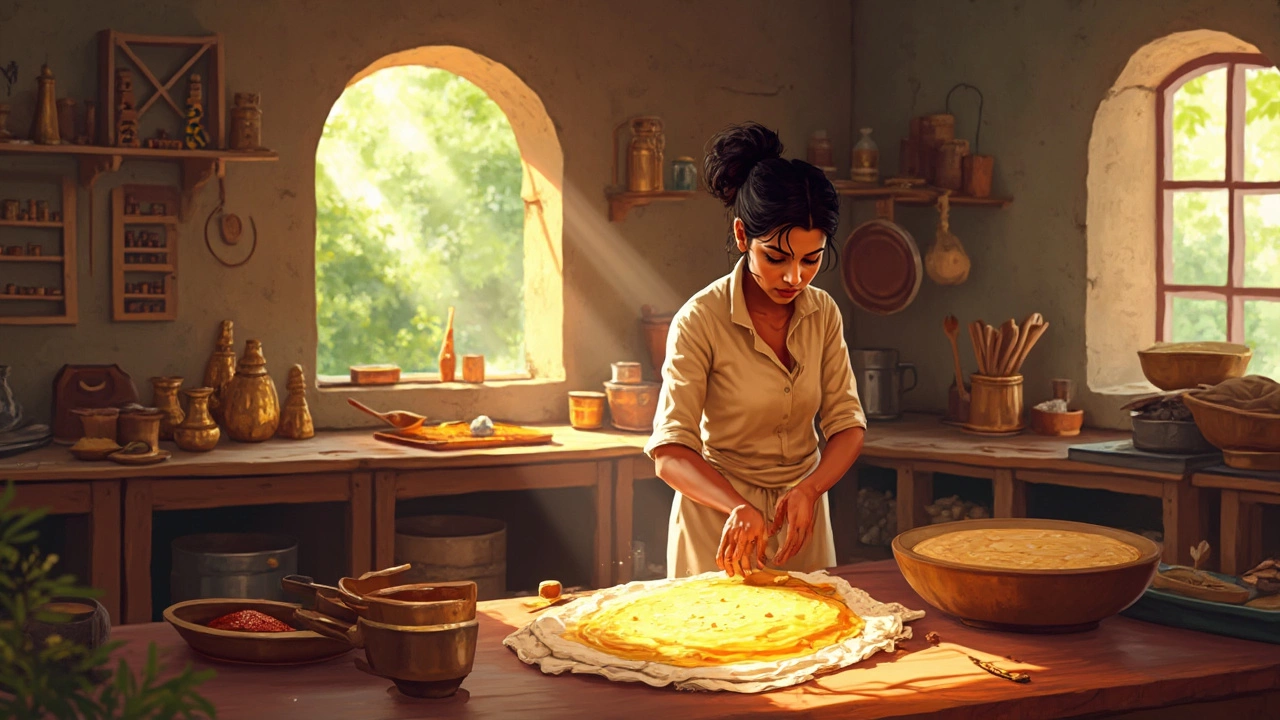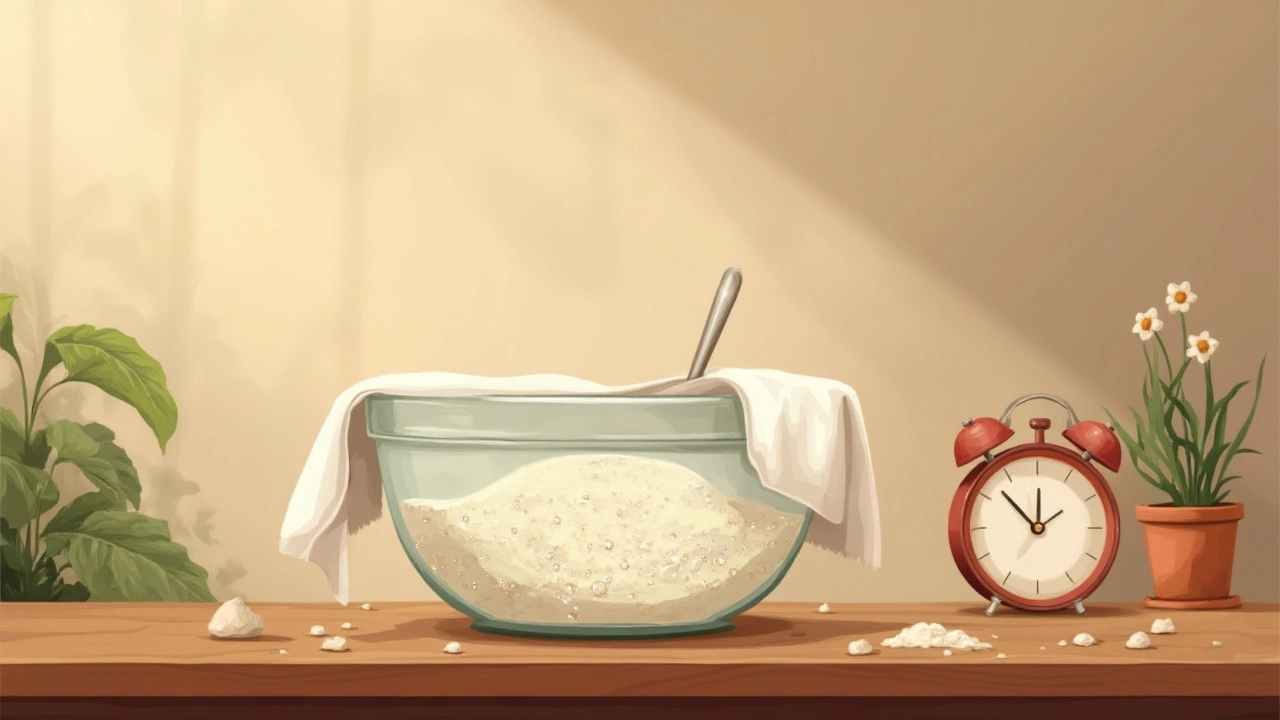Quick Tips for Perfect Dosa Batter Without Yeast
 Feb, 14 2025
Feb, 14 2025
Making perfect dosa batter without yeast might seem challenging, but with a few tricks up your sleeve, you can nail it every time. Let's start with the basics—ingredients make or break your batter. Usually, you'll want to go for a mix of urad dal (black gram) and rice in the right proportions. A good starting point is one part urad dal to three parts rice. This balance keeps your dosas crispy and light.
Once you've sorted out your ingredients, soaking them properly is key. Give them a good 4 to 6 hours soak to soften up. This helps in grinding them to a fine paste later, ensuring smooth batters and, eventually, dosas that are both crispy and soft.
- Essential Ingredients and Ratios
- Steps for Preparation
- Fermentation Techniques
- Troubleshooting Common Issues
Essential Ingredients and Ratios
Creating an incredible dosa batter without yeast starts with getting the ingredients and their ratios just right. It's all about finding that perfect balance between texture and taste. Here’s a breakdown of what you need to kick things off:
Key Ingredients
- Rice: Typically, a combination of regular rice and parboiled rice works wonders. The usual choice is three parts rice to one part urad dal. Parboiled rice adds that extra crispiness.
- Urad Dal: These black grams are a must for fluffiness and are key to achieving an airy batter.
- Fenugreek Seeds: Adding a teaspoon of these helps in natural fermentation, enhancing both flavor and texture.
- Water: Of course, you’ll need water to soak, grind, and adjust the batter consistency.
Ratios and Soaking
The typical ratio that's tried and tested is one part urad dal to three parts rice. Some folks like to add a bit of chana dal to get that golden color and extra crunch. To get started, soak the rice and dal separately for about 4 to 6 hours. This softens them, making the grinding process much smoother.
Preparation Tips
- Soak your rice and urad dal, as well as a teaspoon of fenugreek seeds, till you're sure they're softened.
- Grind the dal first, adding water gradually, until it’s a smooth, fluffy paste. Consistency is key here.
- Next, grind the rice with a bit of water till it’s finer but still slightly grainy. This gives the dosa its characteristic texture.
- Mix both batters together, adding water to achieve a semi-thick but pourable consistency.
By focusing on these essential ingredients and their ratios, you’re on your way to making tasty, restaurant-style dosa without yeast. Remember, a good batter needs some love and patience, but the results are undoubtedly worth it!
Steps for Preparation
Getting the dosa batter right without using yeast is all about following a simple yet precise method. Let’s break it down into manageable steps so you can have perfect dosas on your plate.
Soaking the Ingredients
Start with soaking the right ingredients. Combine your rice and urad dal in separate containers. Add a bit of fenugreek seeds to the dal to help with fermentation later. Soak both for 4-6 hours minimum, or overnight if that’s easier for you.
Grinding to Perfection
Next, you’ll need to grind these soaked ingredients into a fine paste. Use a blender or a traditional wet grinder if you have one. Start with the dal; add a little water to reach a smooth, fluffy consistency. Move to the rice, ensuring it’s ground into a slightly coarse paste. Mix both together in a large bowl.
Achieving the Right Consistency
Consistency is key! The batter should be neither too thick nor runny. Think pancake batter—that’s your sweet spot. Add water in small increments until you hit the mark. This will make it easier to spread the batter on a hot griddle or tawa.
Naturally Fermenting the Batter
This is where the magic happens. For natural fermentation, let the mixed batter sit in a warm place for about 8-12 hours. Cover the bowl but don’t seal it airtight; it needs some air to ferment properly. Look for tiny bubbles on top, indicating your batter is ready for action.
Quick Tips for Perfection
- Salt—add it right before cooking the dosas to help retain the fermenting action.
- Temperature—warmer temperatures speed up fermentation, while colder climates slow it down.
- Repertoire—test different rice types to find what works best for your taste.

Fermentation Techniques
Fermenting your batter without yeast is more of a science meets art kind of thing. And yes, it's totally doable—it just takes a little patience and the right conditions.
The Right Environment
Your batter needs a cozy spot in your kitchen, not too hot but not too cold. Ideal temps hover around 75°F to 85°F. If you live in a cooler place, try placing the bowl in your oven or on top of the fridge (just make sure the oven isn't on!).
Timing is Key
Fermentation can take anywhere from 8 to 12 hours, sometimes even a bit more. You'll know it's ready when you spot little air bubbles on the surface and it has noticeably risen. If it smells a bit sour, you've struck gold.
Tricks for Better Fermentation
- Salt Later: Add salt right before you cook. Adding it too soon can slow down the fermentation process.
- Water Matters: Use filtered water if your tap water sports a lot of chlorine—it can hinder fermentation.
- A Helping Hand: Sometimes, a tablespoon of chana dal can give your fermentation a boost. Invite this legume to the party!
If you’re in a rush, try sticking the batter under sunlight for an hour or two. It often does wonders.
Common Pitfalls
If your batter didn’t ferment, don’t worry. Try adding a sprinkle of fenugreek seeds when grinding your ingredients next time. They can help kickstart the process naturally.
| Temperature | Time |
|---|---|
| 70°F | 15-18 hours |
| 75°F | 8-12 hours |
| 80°F+ | 6-8 hours |
With these techniques, your homemade dosas will shine—crispy, flavorful, and with the perfect texture each time. Happy cooking!
Troubleshooting Common Issues
Even seasoned cooks hit a snag with their dosa batter from time to time. But no worries, we’ve got you covered with some quick fixes for the most common problems.
Issue 1: Batter Isn't Fermenting
Feeling let down by pesky non-fermenting batter? It could be the temperature. Dosa batter loves warmth. If it's too cold, try placing it in a warm spot, maybe in your oven with just the light on or near a heater.
- Ensure adequate fermentation time: about 8-12 hours.
- Salt can hinder fermentation, so add it after the process, just before cooking.
Issue 2: Batter Too Thick or Thin
Thickness throws off the perfect dosa game. If too thick, the dosa won't spread well, and if too thin, it breaks easily. For the consistency of a pancake batter:
- Add water a little at a time to thin down the batter.
- If it's too thin, mix in some semolina to thicken it up without affecting the taste.
Issue 3: Dosas Sticking to the Pan
When dosas play hard to get and stick to the pan, it's frustrating! This might happen because of:
- Improper pan heat. Ensure the pan is hot before pouring the batter. Use water droplets to check—if they sizzle, you're good to go.
- Using a nonseasoned pan. A well-seasoned cast-iron pan works best. Rub some oil before each dosa for an extra non-stick effect.
See the below stats that help in understanding common issues frequency:
| Issue | Frequency (%) |
|---|---|
| Batter Not Fermenting | 40% |
| Batter Consistency Problems | 35% |
| Sticking Dosas | 25% |
These tips will have your cooking game back on track, with crispy, delicious dosas in no time.